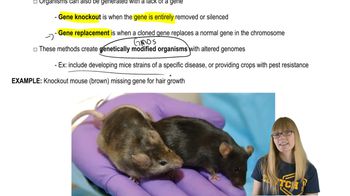The CRISPR-Cas system has great potential but also raises many ethical issues about its potential applications because, theoretically, it can be used to edit any gene in the genome. What do you think are some of the concerns about the use of CRISPR-Cas on humans? Should CRISPR-Cas applications be limited for use on only certain human genes but not others? Explain your answers.
Table of contents
- 1. Introduction to Genetics51m
- 2. Mendel's Laws of Inheritance3h 37m
- 3. Extensions to Mendelian Inheritance2h 41m
- 4. Genetic Mapping and Linkage2h 28m
- 5. Genetics of Bacteria and Viruses1h 21m
- 6. Chromosomal Variation1h 48m
- 7. DNA and Chromosome Structure56m
- 8. DNA Replication1h 10m
- 9. Mitosis and Meiosis1h 34m
- 10. Transcription1h 0m
- 11. Translation58m
- 12. Gene Regulation in Prokaryotes1h 19m
- 13. Gene Regulation in Eukaryotes44m
- 14. Genetic Control of Development44m
- 15. Genomes and Genomics1h 50m
- 16. Transposable Elements47m
- 17. Mutation, Repair, and Recombination1h 6m
- 18. Molecular Genetic Tools19m
- 19. Cancer Genetics29m
- 20. Quantitative Genetics1h 26m
- 21. Population Genetics50m
- 22. Evolutionary Genetics29m
18. Molecular Genetic Tools
Genetic Cloning
Problem 30
Textbook Question
The RAS gene encodes a signaling protein that hydrolyzes GTP to GDP. When bound by GDP, the RAS protein is inactive, whereas when bound by GTP, RAS protein activates a target protein, resulting in stimulation of cells to actively grow and divide. As shown in the accompanying sequence, a single base-pair mutation results in a mutant protein that is constitutively active, leading to continual promotion of cell proliferation. Such mutations play a role in the formation of cancer. You have cloned the wild-type version of the mouse RAS gene and wish to create a mutant form to study its biological activity in vitro and in transgenic mice. Outline how you would proceed.

 Verified step by step guidance
Verified step by step guidance1
Step 1: Identify the specific mutation in the RAS gene sequence that leads to the constitutively active mutant protein. This can be done by comparing the wild-type RAS gene sequence to the mutant sequence and pinpointing the single base-pair change responsible for the altered activity.
Step 2: Design a primer for site-directed mutagenesis. This primer should contain the desired mutation (single base-pair change) and be complementary to the wild-type RAS gene sequence, except for the specific nucleotide to be altered.
Step 3: Perform site-directed mutagenesis using a PCR-based method. Amplify the RAS gene using the designed primer and a high-fidelity DNA polymerase to introduce the mutation into the gene. Ensure that the reaction conditions are optimized for specific and accurate amplification.
Step 4: Verify the introduction of the mutation by sequencing the PCR product. This step ensures that the desired mutation has been successfully incorporated into the RAS gene without introducing any unintended changes.
Step 5: Clone the mutant RAS gene into an appropriate expression vector for further study. This vector can then be used to express the mutant protein in vitro or to generate transgenic mice for in vivo studies of its biological activity.
 Verified video answer for a similar problem:
Verified video answer for a similar problem:This video solution was recommended by our tutors as helpful for the problem above
Video duration:
1mPlay a video:
Was this helpful?
Key Concepts
Here are the essential concepts you must grasp in order to answer the question correctly.
RAS Protein Function
The RAS protein is a critical signaling molecule that regulates cell growth and division. It functions as a molecular switch, toggling between an active form bound to GTP and an inactive form bound to GDP. When activated by GTP, RAS interacts with various downstream effectors to promote cellular processes such as proliferation. Understanding this mechanism is essential for studying mutations that lead to uncontrolled cell growth, as seen in cancer.
Recommended video:
Guided course

Proteins
Mutagenesis Techniques
Mutagenesis refers to the process of inducing mutations in a gene to study its function. Techniques such as site-directed mutagenesis allow researchers to create specific alterations in the DNA sequence of the RAS gene, resulting in a mutant protein. This approach is crucial for investigating how particular mutations affect RAS activity and contribute to cancer development, enabling the exploration of potential therapeutic targets.
Recommended video:
Guided course

Induced Mutations
Transgenic Mouse Models
Transgenic mouse models are genetically modified organisms that carry foreign genes or mutations, allowing researchers to study gene function and disease mechanisms in a living system. By introducing the mutant RAS gene into mice, scientists can observe the biological effects of the mutation in vivo, including its role in tumorigenesis. These models are invaluable for understanding the complexities of cancer biology and testing potential treatments.
Recommended video:
Guided course

Transgenic Organisms and Gene Therapy
Related Videos
Related Practice
Textbook Question
573
views


